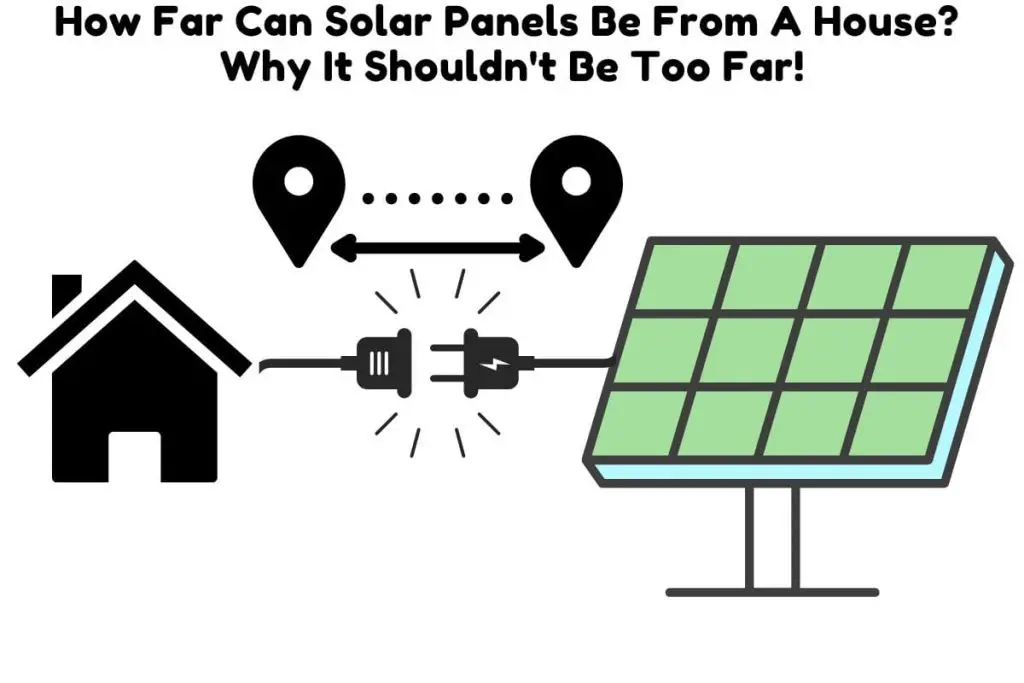Solar panels can be located at almost any distance from a house. In practice, however, the shorter the distance between where the electricity is generated and where it will be used, the more efficient a system is. This is why it is advisable to keep the distance between the solar panels and the inverter or batteries under 30 feet.

But Why or How Is This Important to Solar System Design?
How a solar system loses power
Several factors induce power loss in a solar panel system. These include shading, heat, dirt on the solar panels, and of course cable losses. Shading results in the most losses at an average of 7%.
However, cable losses reduce the power output of solar systems by up to 3%. The losses become greater as you add longer cables. On average AC cable losses are about 0.5%, while DC cable losses are around 1%. But what causes cable loss? Source
Voltage drops
Voltage drop is a factor you have to consider when designing a solar system. It affects how much energy a system will produce. Voltage drop is the cause of cable losses in a PV system.
On a side note! If you’re in need of a reliable and high-performance portable solar panel, We strongly recommend the Jackery SolarSaga 100W Portable Solar Panel (Amazon Link).
With a high conversion efficiency and foldable design, this solar panel is easy to transport and set up, making it perfect for outdoor activities like camping, hiking, and RV trips.

The US solar cell technology used in this panel ensures that you get the most efficient and reliable solar charging possible.
There is also a 60W option that is more affordable (Amazon Link)
Moving electricity from one point to another reduces the amount of available electricity. It is like moving water from a well into a pipe and through to a tap. Along the way, some of the water is lost. The further away you are from the well, the longer the pipe will be and the more losses there are.
Solar functions on the same principle. Only here, the well is the solar panels and the pipe is the cables that connect the solar panels to the rest of the system.
The longer the cables are the more electricity is lost.
(Check out our post How Far Can Solar Panels Be From An Inverter? Why It Should Be Close-by!
& How Far Can Solar Panels Be from Battery and Other Components?“
This happens because of resistance. Cables conduct electricity but they also resist the flow of electricity. Voltage drop is the difference between the voltage at the solar panels and the voltage at your battery or inverter. It tells you how much resistance there is in your cables.
In simple terms, the more cable you have in terms of length and thickness, the more resistance there will be in your system. That means your system will produce less energy as you add more cable. According to the National Electric Code (NEC), the voltage drop in your system should be less than 3%. Source
Can Solar Panels Be Put Anywhere?
Solar panels are either roof or ground-mounted. Most solar panel installations are roof mounts primarily because it is a more efficient use of space compared to a ground mount.
When should you opt for either a ground or roof mount? Let’s look at the specific advantages and disadvantages of each.
Roof mounts
A roof mount is the best choice for most homeowners. Roof-mounted solar panels make use of space that would otherwise lie idle. It conveniently places the solar panels in an out-of-the-way position. Roof mounts have several other advantages including:
- They are generally cheaper, as they require less labor and racking equipment.
- Roof-mounted solar panels are more secure from theft or tampering.
The major downside to a roof mount is the reduced accessibility. This makes them harder to clean and service.
Ground mounts
Ground mounts are an alternative where there isn’t enough space on the roof or if the roof is not in good condition. The biggest advantage of a ground mount is accessibility. As they are on the ground, cleaning and maintaining the solar panels is much easier. Other advantages include:
- The system isn’t limited by roof size.
- It’s much cooler on the ground than on the roof so there are fewer losses in solar panel output caused by temperature.
The biggest disadvantage of a ground mount is that the installation can be more expensive due to the added labor and racking costs.
How Far Apart Can Solar Panels Be?
Solar panel frames expand and contract depending on the temperature. A gap of between four to seven inches allows for heat-induced expansion of solar panels. This prevents the solar panels from pressing into each other. There should also be walking space of between one to three feet between rows of solar panels.
The walking space allows for easier access to solar panels. This is necessary when you want to clean the solar panels or when servicing or repairs need to be done.
It’s also advisable to leave a space of 12 inches between the solar panels and the edge of the roof. This is because wind force is strongest at the edge of the roof. Solar panels will have less wind load and are less likely to be blown off the roof if they are further away from the edges.
While most roofs can accommodate up to 90 solar panels, having more panels than you need is not practical.
Can You Have Too Many Solar Panels?
The average solar installation uses between 15 to 25 solar panels. This is enough to meet the energy requirements of most households. Expanding solar energy capacity far beyond consumption does not yield any tangible benefit for a homeowner.
Sizing a solar system is an important step in system design. It should depend on the homeowner’s consumption. How well it’s done determines whether the system will produce too much or not enough energy.
The best practice is to slightly oversize the system once the consumption has been worked out. This is by no more than 20% and is only to allow for inefficiencies in the system.
What Happens If My Solar Panels Produce More Energy Than I Use?
The excess energy in a solar system will be fed into the grid if it’s a grid-tied system. Excess in an off-grid system has no outlet so it simply becomes wasted energy if there are no appliances to use it or additional storage.
Net metering is when you export electricity to the grid and get credits from your utility in return. This is one of the attractions of having a grid-tie solar system. The excess your system produces can help you reduce your electricity bill. Source
